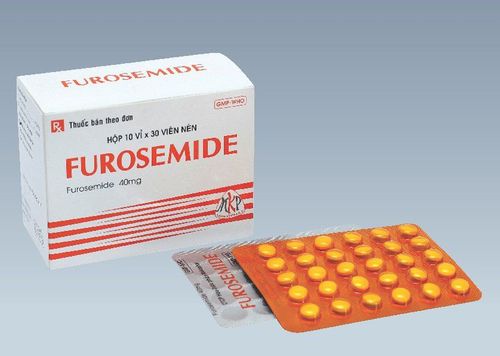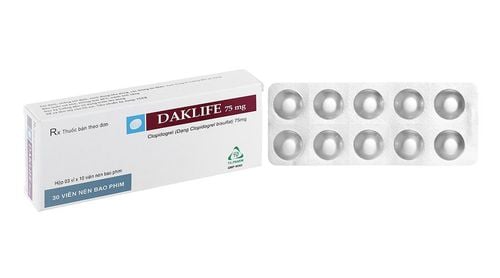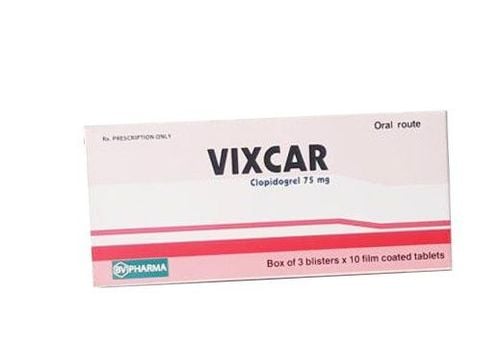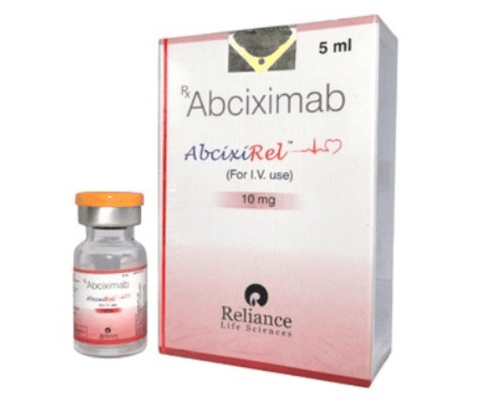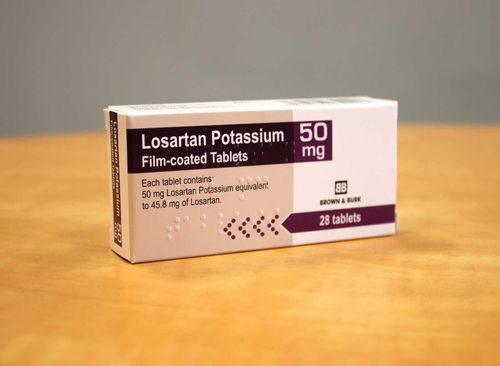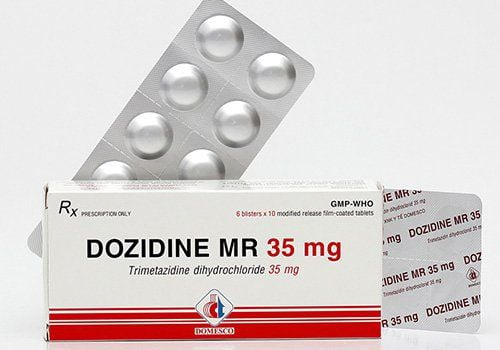This is an automatically translated article.
Razugrel 5 drug commonly used in the treatment of blood clotting contains the main ingredient prasugrel. Let's find out more details about the uses, usage and notes when using Razugrel 5 through the article below.
1. What is Razugrel?
Razugrel 5 is a prescription drug, belongs to the group of cardiovascular drugs. Razugrel is used to treat blood clotting effectively.
Razugrel 5 is prepared in the form of film-coated tablets, each tablet contains the main ingredient Prasugrel in the form of prasugrel hydrochloride 5mg and other excipients such as: Mannitol, Microcrystalline Cellulose, Hydroxy Propyl Cellulose, Sodium croscarmellose, Magnesium Stearate, Opadry Pink, Insta Glow white.
2. Indications for use of Razugrel 5
Razugrel 5 is used in the following cases:
Preventing blood clots in people with acute coronary syndromes, people undergoing surgery after a recent stroke or heart attack, people with tangles certain disorders of the heart or blood vessels, patients with ACS, unstable angina. In combination with aspirin for the prevention of thrombosis in elderly patients with acute coronary syndromes such as angina, myocardial infarction with or without gap, undergoing PCI.
3. Dosage and how to use Razugrel 5
3.1. How to use Oral medication. The patient should take the medicine with a full glass of water. The tablet should be swallowed whole, do not break or crush the tablet. Can be taken on an empty stomach or on an empty stomach. 3.2. Dosage Adults:
Initial dose from 60mg / 1 time only / day. Then use a maintenance dose of 10mg/time/day. In UA/NSTEMI patients who have had coronary angiography within 2 days of admission, the starting dose should be administered only at the time of percutaneous coronary intervention. Patients taking Prasugrel should take ASA daily (dose 75mg - 325mg). In patients with PCI-controlled acute coronary syndromes, premature discontinuation of any antiplatelet agent including prasugrel may result in an increased risk of thrombosis, myocardial infarction, or death from underlying diseases. patient. Treatment for up to 12 months is recommended unless discontinuation of Prasugrel is clinically indicated. Elderly people over 75 years old:
The use of the drug in this age group is generally not recommended. If the benefits and risks are carefully assessed in each individual patient by the physician, treatment with Razugrel 5 will be considered necessary. Initial dose is 60mg and maintenance dose is at 5mg. Patients over 75 years of age are more susceptible to bleeding and absorb the active metabolite prasugrel. Patients weighing < 60kg:
The first dose is 60mg/day and a single dose. Maintenance dose is 5mg/time/day and should not exceed 10mg/day. Because patients with body weight < 60 kg when dosing 10 mg once daily will increase the risk of bleeding due to increased exposure to the active metabolite of prasugrel in patients with body weight > 60 kg. kg. Patients with renal impairment:
No dose adjustment of Prasugrel is required in this population including patients with end-stage renal failure. However, there is limited experience in treating patients with renal failure. Hepatic impairment:
No dose adjustment of Prasugrel is required in subjects with mild or moderate hepatic impairment. Experience in drug therapy in patients with mild and moderate dysfunction is limited. Prasugrel absolutely should not be used in patients with severe liver failure. Children:
Safety and effectiveness in children under 18 years of age have not been established and no data are available for study. Therefore, Prasugrel should not be used in this population.
4. Contraindications to the use of Razugrel 5
Razugrel 5 should not be used in the following cases:
Patients with active pathological bleeding such as bleeding in the brain or stomach ulcers. Patients with a history of transient ischemic attack or stroke. Patients with hypersensitivity to Prasugrel or any other ingredient in the drug. Patients before or after heart surgery. Patients with severe liver disease.
5. Side effects when using Razugrel 5 treatment
During the treatment with Razugrel 5, patients may experience some unwanted side effects that have been reported as follows:
Cardiovascular: Hypertension, hypotension, atrial fibrillation , bradycardia, noncardiac chest pain, peripheral edema, thrombocytopenic purpura (TTP) Central nervous system: Headache, dizziness, fatigue, fever, extremity pain. Dermatology: Rash, bruising. Endocrine and metabolic: Hyperlipidemia or hypercholesterolemia. Gastrointestinal: Gastrointestinal bleeding, nausea, diarrhea. Hematology: Leukopenia, anemia, bleeding, including symptomatic intracranial hemorrhage, leukopenia. Immune system: Hypersensitivity including angioedema. Typical neuromuscular and skeletal conditions are low back pain, noncardiac chest pain, and extreme pain. Respiratory: Shortness of breath, cough, nosebleeds, hemoptysis. Eyes: Eye hemorrhage. Overall: Fatigue and fever Urinary: Blood in the urine Patients should immediately notify the doctor, pharmacist when experiencing any unusual symptoms suspected as side effects of the drug or immediately go to medical facilities. near home when there are serious and dangerous symptoms for timely examination and treatment.
6. Razugrel 5 . drug interactions
Razugrel 5 affects other drugs when used together as follows:
CYP3A inhibitors - Ketoconazole 400mg/day (a potent and selective inhibitor of CYP34A and CYP3A5) will not affect the platelet inhibition of Prasugrel or the active AUC and Tmax but will reduce Cmax by 34% - 46%. Therefore, CYP3A inhibitors such as: Diltiazem, Verapamil, Indinavir, Clarithromycin, Ciprofloxacin and grapefruit will not significantly affect the pharmacokinetics of the drug. Cytochrome P450 Inducer - Rifampicin 600mg/day (a strong inducer of CYP3A and CYP2B6, CYP2C9, CYP2C19 and CYP2C8) will not significantly alter the pharmacokinetics of Prasugrel metabolism or inhibit platelet aggregation. However, CYP3A inducers such as Carbamazepine, Rifampicin or Cytochrome P450 inducers do not have a significant effect on the pharmacokinetics of the drug. Drugs that increase gastric pH include proton pump inhibitors and H2 blockers when combined. with Razugrel 5 can reduce the Cmax of the active metabolite Prasugrel by 14% and 29% respectively but without changing the Tmax and AUC of the activator.Statins such as Atorvastatin - a drug metabolized by CYP4503A4 when administered Co-administration with prasugrel did not alter its pharmacokinetics or inhibit platelet aggregation.Co-administration of Heparin with prasugrel did not significantly alter coagulation or inhibit platelet aggregation with prasugrel. Bleeding time with Prasugrel alone Pirin when used 150 mg/day in combination with prasugrel alters the inhibition of prasugrel mediated by platelet aggregation and increases bleeding time when prasugrel is used alone. Concomitant use of warfarin and other NSAIDs with prasugrel increases the risk of bleeding. In addition, in vitro metabolism studies concluded that the major circulating metabolites of Razugrel 5 are unlikely to cause significant inhibition of CYP2C9, CYP3A, CYP1A2, CYP2C19, CYP2D6, CYP3A. Therefore, Prasugrel does not significantly affect metabolism by CYP2B6 such as Cyclophosphamide, Halothan, Propofol and Nevirapine. Digoxin in combination with Prasugrel will not affect the absorption and distribution of Diogin. To ensure safety during the use of Razugrel 5, patients should report to their doctor or pharmacist all the medicines they are taking and any medical conditions they are having so that the doctor or pharmacist can guide them to use them. the most suitable medicine for you.
7. Notes when using Razugrel 5 for treatment
Razugrel 5 when clinical studies in animals did not reveal an effect of the drug on pregnancy, development or later parturition. However, the data are incomplete and controlled in pregnant women. Therefore, the use of Prasugrel in this population should only be used after careful consideration of the potential benefits and risks under the direction of a doctor or pharmacist.
There are no data to show whether Prasugrel is excreted in human milk. However, Prasugrel has been found in animal (rat) milk. Therefore, it is necessary to consider carefully before using Prasugrel for nursing women to limit the harm to the newborn.
There is no evidence that Prasugrel affects the ability to drive and use machines.
8. What should be done in case of an overdose of Razugrel 5?
When a patient accidentally overdoses on Razugrel 5 may experience some of the following symptoms:
Inhibition of platelet aggregation caused by prasugrel rapidly and irreversibly, prolongs the life of platelets and is difficult to increase in case of overdose. In clinical experiments on rats, it was concluded that the mortality rate was 2000mg/kg. Symptoms may include: Blurred vision, difficulty breathing, watery eyes, difficulty walking, bloody stools or vomiting blood. Patients should immediately go to the nearest medical facility if they suspect they have overdosed. At this time, platelet transfusion is applied to restore blood clotting. The method of dialysis does not work in case of an overdose of Razugrel 5. Hopefully the information shared above will help patients have more useful information about the Razugrel 5 drug line. Always refer to the medication instructions carefully to ensure health safety while taking Razugrel 5.
Please dial HOTLINE for more information or register for an appointment HERE. Download MyVinmec app to make appointments faster and to manage your bookings easily.




